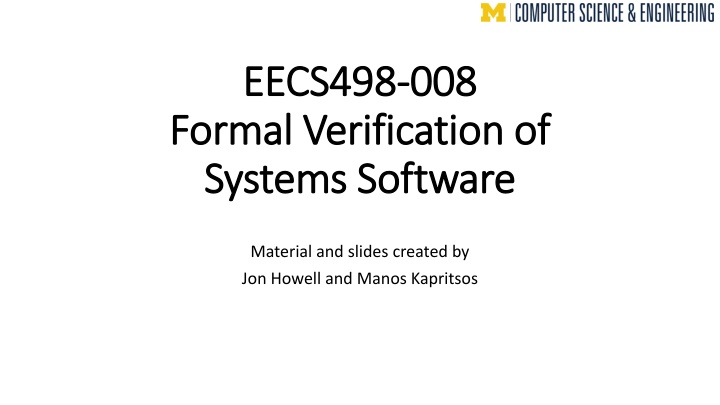
Formal Verification in Systems Software: Understanding State Machine Behavior
This material delves into the formal verification of systems software, focusing on state machine definitions and behaviors. It covers topics such as state space, state assignment, and predicates for state transitions like CheckOut and CheckIn. The content emphasizes the importance of deterministic and non-deterministic behavior analysis, presenting a structured approach to ensuring software correctness and robustness.
Download Presentation

Please find below an Image/Link to download the presentation.
The content on the website is provided AS IS for your information and personal use only. It may not be sold, licensed, or shared on other websites without obtaining consent from the author. If you encounter any issues during the download, it is possible that the publisher has removed the file from their server.
You are allowed to download the files provided on this website for personal or commercial use, subject to the condition that they are used lawfully. All files are the property of their respective owners.
The content on the website is provided AS IS for your information and personal use only. It may not be sold, licensed, or shared on other websites without obtaining consent from the author.
E N D
Presentation Transcript
EECS498 EECS498- -008 Formal Verification of Formal Verification of Systems Software Systems Software 008 Material and slides created by Jon Howell and Manos Kapritsos
A A state state is an assignment of values to variables is an assignment of values to variables datatype Card = Shelf | Patron(name: string) datatype Book = Book(title: string) type Variables = map<Book, Card> The state space is the set of possible assignments. The Martian: Jon Snow Crash: Jon The Martian: Shelf Snow Crash: Shelf The Martian: Shelf Snow Crash: Jon The Martian: Manos Snow Crash: Jon 9/21/22 EECS498-008 2
A A state machine definition state machine definition datatype Card = Shelf | Patron(name: string) datatype Book = Book(title: string) type Variables= map<Book, Card> predicate Init(v: Variables) { forall book | book in v :: v[book] == Shelf } predicate CheckOut(v : Variables, v : Variables, book: Book, name: string) { && book in v && v[book] == Shelf && (forall book | book in v :: v[book] != Patron(name)) && v == v[book := Patron(name)] } predicate CheckIn(v : Variables, v : Variables, book: Book, name: string) { && book in v && v[book] == Patron(name) && v == v[book := Shelf] } predicate Next(v: Variables, v : Variables) { || (exists book, name :: CheckOut(v, v , book, name)) || (exists book, name :: CheckIn(v, v , book, name)) } enabling condition update Nondeterministic definition 3
A A behavior behavior is is the set the set of of all possible all possible executions executions predicate CheckOut(v, v , book, name) { && book in v && v[book] == Shelf && (forall book | book in v :: v[book] != Patron(name)) && v == v[book := Patron(name)] } predicate CheckIn(v, v , book, name) { && book in v && v[book] == Patron(name) && v == v[book := Shelf] } check out ??? The Martian: Shelf Snow Crash: Shelf The Martian: Shelf Snow Crash: Jon The Martian: Shelf Snow Crash: Rob 4
State machine strengths State machine strengths Abstraction States can be abstract Model an infinite map instead of an efficient pivot table Next predicate is nondeterministic: Implementation may only select some of the choices Can model Murphy s law (e.g. crash tolerance) or an adversary 5
State machine strengths State machine strengths Abstraction Asynchrony Each step of a state machine is conceptually atomic Interleaved steps capture asynchrony: threads, host processes, adversaries Designer decides how precisely to model interleaving; can refine/reduce 6
State machine strengths State machine strengths Abstraction Asynchrony Environment Model a proposed program with one state machine (verified) Model (adversarial) environment with another (trusted) Compound state machine models their interactions (trusted) System (environment assumption) Distributed System (environment assumption) Disk Network (environment assumption) Host Filesystem (program to verify) (environment assumption) (program to verify) 7
Chapter 4: Proving properties Chapter 4: Proving properties Expressing a system as a state machine allows us to prove that it has certain properties We will focus on safety properties i.e. properties that hold throughout the execution Basic tool: induction 657 657 658 658 0 0 1 1 2 2 3 3 Show that the property holds on state 0 Show that if the property holds on state k, it must hold on state k+1 8
Lets prove a safety Let s prove a safety invariant! invariant! predicate Safety(v:Variables) { true // TBD } Base case lemma SafetyProof() ensures forall v :: Init(v) ==> Safety(v) ensures forall v, v' :: Safety(v) && Next(v, v') ==> Safety(v') { } Inductive Step 9
Lets prove a safety invariant! Let s prove a safety invariant! Interactive proof development in editor Bisection debugging, case analysis, existential instantiation 10
Jay Jay Normal Form Normal Form As you begin writing more interesting specs, proofs will be nontrivial. Pull all the nondeterminism into one place, and get a receipt. image: flickr/afagen CC-by-nc-sa 11
Jay Normal Form Jay Normal Form datatype Step = | Action1Step( <parameters> ) | Action2Step( <parameters> ) ... predicate NextStep(v: Variables, v : Variables, step:Step) { match step case Action1Step(<parameters>) => Action1(v, v , <parameters>) case Action2Step(<parameters>) => Action2(v, v , <parameters>) ... } predicate Next(v: Variables, v : Variables) { exists step :: NextStep(v, v , step) } 12
